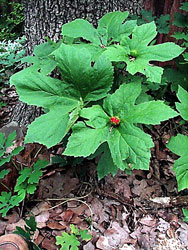Resource Library
Plant of the Week: Goldenseal
The University of Arkansas System Division of Agriculture does not promote, support or recommend plants featured in "Plant of the Week." Please consult your local Extension office for plants suitable for your region.
Plant of the Week
Goldenseal
Latin: Hydrastis canadensis

Shade gardens present an opportunity to grow a wide variety of plants native to the forested woodlands of eastern North America. One of my favorites is goldenseal (Hydrastis canadensis), a plant more commonly thought of as a medicinal herb than a garden ornamental.
Goldenseal is an herbaceous plant that rises from the ground each spring from a tight clump of yellow rhizomes. It reaches about a foot tall when fully grown. A single forked stem arises from the terminus of each rhizome and produces a pair of celery-green leaves in early spring. The pubescent leaves are displayed flat on top with five prominent lobes and can be as much as 10 inches across.
In mid-spring an inch-wide white apetalous flower consisting of a dense cluster of stamens appears at the fork between the two leaves. Following the flower in July is a ball-shaped red berry about 1.5 inches across. Goldenseal belongs to the buttercup family and is monotypic, with only one closely related species occurring in Japan.
Goldenseal has long been used in herbal medicine. Native Americans – including the Cherokees – used the root as a treatment for cancer and to treat localized lesions. Modern medicine has identified the drug berberine (and several others) in the root extract. Berberine, which is produced by several other plant species, has been shown to have antibiotic properties.
Though traditional medicine feels there is little scientific evidence to support its use as an herbal remedy, modern herbalists disagree. It’s the sixth most common drug used in herbal preparations.
Plants for drug extraction have been collected from the wild in its native range – primarily high ground from southeastern Canada and through most of the eastern woodlands – for more than two centuries. Because of over-collection, it is becoming rare in the wild and has been listed as threatened or endangered in some states. Fortunately, the herb is easy to grow, and commercial plantings are now common throughout its native range and in the Pacific Northwest. Plants large enough to dig are produced in five to six years from rhizome divisions, while it takes six to seven years for plants grown from seed.
In the garden, goldenseal is easy to grow in any moderately moist and well-drained soil supplemented with an abundant supply of organic matter. It mixes well with other woodlanders, such as Solomon seal, bloodroot, mayapple and trilliums. Plant it in patches along the woodland path or in clusters, where the bold leaf display can be enjoyed.
By: Gerald Klingaman, retired
Extension Horticulturist - Ornamentals
Extension News - May 1, 2009
The University of Arkansas System Division of Agriculture does not maintain lists of retail outlets where these plants can be purchased. Please check your local nursery or other retail outlets to ask about the availability of these plants for your growing area.